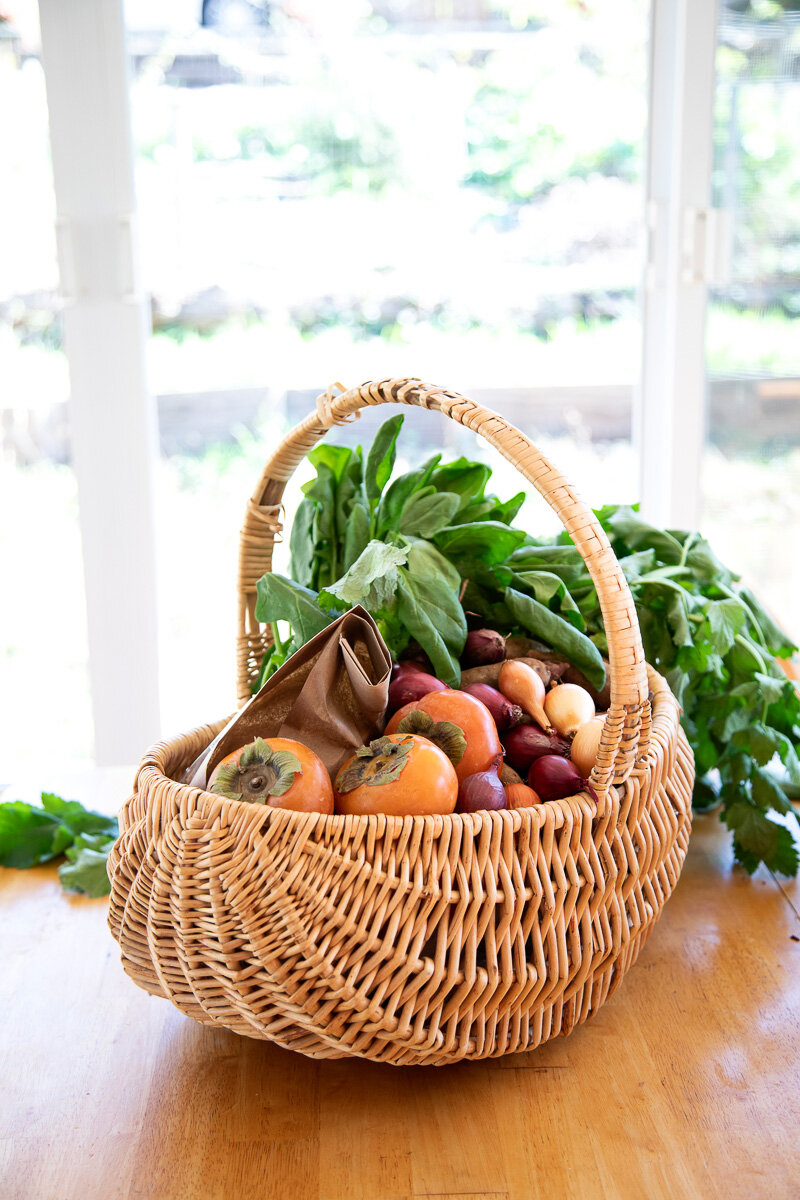How to prepare for a local food diet
Does the idea of "local food" and "slow food" resonate with you? Are you curious to see what it would be like to eat only from your own region's farmers and producers for a period of time?
This month, I'm committing to one month of eating only from my bioregion (the Asheville area in Western North Carolina). In this post, I share what I learned while preparing for this local food challenge in case it's useful for others doing something similar.
Here, in a nutshell, are the steps that helped me to prepare for my Locavore Month:
Why: Get clear on your motivations for committing to local foods.
How: decide some parameters for your experiment.
Research: What do I eat, what's available locally, who's growing/making it?
Develop some good old-fashioned kitchen skills before starting.
Make preparations.
Photo: Erin Adams
Why Eat a Local Food Diet
If you're not clear on your motivations for undertaking a local foods experiment, it's going to be hard to stick to it. The first mango smoothie or bag of processed chips that comes your way is going to be hard to turn down if you treat this as just another fad diet.
There are profound reasons for taking a stand in defense of local foods. The current industrial food system and our imported, processed-food diets are causing visible, real damage — in terms of public health, the environment, and adding to the fossil-fuel dependency of our lifestyles. Local foods, in contrast, come from family farms whose growing practices we can check. Investing in them strengthens the local economy. Because these foods are freshly harvested, they are so much more superior in flavor and nutrition than the plastic-wrapped items that have been sitting on supermarket shelves for who knows how long.
Does one person's commitment to shift to local foods change the system? No, it doesn't. But it's more than a symbolic gesture.
Eating locally concretely reduces our dependence on the industrial processed-food system and tethers us, instead, more deeply to our own region's food system and the people who are involved in it. It teaches us that we can eat — and eat well — even without the supermarkets, the 18-wheeler trucks, and the pesticide-laden fields somewhere far away. That experience is a rare one in the modern world, and really powerful. And the more people get a taste of that, the stronger the local food and slow food movements are going to grow.
How to Eat a Local Food Diet
Next, decide some parameters for your local food experiment:
What’s “local” to you? Where do you draw the line? Some people commit to a 100-Mile Diet. Even eating foods produced in one’s own state makes an enormous difference compared to the average American diet.
How hard-core do you want to be? For example, where I live we have a local cracker company, a hummus company, and a chocolate factory. But the raw ingredients they use — the flour, the chickpeas, and the cacao beans, respectively — come from elsewhere. Do they still count as local food? Decide what's reasonable for you.
Who lives with you, and are they going to participate?
The timing of your local food experiment is important. I recommend choosing a time when the availability of local foods in your area is at its height. For example, in the northern hemisphere, July, August, or September are going to be much more flavorful and abundant than January, February, or March.
I recommend following Barbara Kingsolver’s advice to choose one loophole item — "one luxury item each in limited quantities, on the condition we’d learn how to purchase it through a channel most beneficial to the grower and the land where it grows.” Think coffee, spices, coconut or olive oil — whatever it is that you'd be miserable without. Being miserable is not the point. (My "loophole item," by the way, is black tea.)
The focus of a locavore month should not be: "What do I have to give up?" but rather, “What do I get to eat?” This is your opportunity to eat fresh, to try your region's specialties, to try the recipe you've always wanted to make. Take the time to cook and eat slowly. Share your local meals with friends.
Research
Planning a month of local eating teaches you so much, both about what you eat, and what is available locally.
First write down all the food groups, food items, beverages etc. you normally consume.
Then do some detective work. What farms and food producers are in my area? What do they have on offer? Which food group needs can I meet locally?
Farmers’ markets are the tastiest way to familiarize yourself with the local farms and food producers and their offerings. Try samples. Talk to people. Only then talk to Google.
Develop some old-fashioned kitchen skills
A locavore diet is a whole foods diet.
What that means is, if you're mostly dependent on the supermarket and processed foods for your sustenance, there's a bit of a learning curve involved. I'd recommend first spending some time learning to cook foods you love from scratch.
Gradually develop more local food sourcing routines. Learn to plan your menus around what is seasonally available. Get to know your local farmers' markets, u-pick farms and farm stands. (Contrary to common misconceptions, produce sourced this way is often cheaper than supermarket produce.)
Pro tip: Plant a vegetable garden! Even just a container of salad greens. That way you'll always have something über-local at your doorstep.
Make friends with people who are gardeners. Once they find out you are restricting yourself to local foods, unexpected loads of green beans, zucchini and freshly picked pears might just land in your lap.
Lastly, here are some good old kitchen skills that will make local eating easier (this is a great resource for recipes and tutorials):
Learn to bake bread.
Learn to make yogurt and cheese (that way, if you have a source of local milk, you're guaranteed a supply of yogurt and cheese as well.
Learn to make your treats and condiments (e.g. ketchup, crackers, and stock) yourself.
Get in the habit of preserving local produce during bumper crop months: freeze berries in July, can tomatoes in August, make applesauce in September.
Learn to identify and forage some local wild edibles, mushrooms, and nuts.
Make preparations
Alright. The start date of your locavore month (or week, or year) is near and you feel ready. Here's what to do in the days leading up to the start of your experiment:
stock up the pantry and the fridge with local staples (here in the Asheville area, I've been able to source flour, rice, nut oils, corn meal and grits, sauerkraut, salsa, local dairy, local grassfed meat and pastured eggs, sustainably farmed trout, and lots of cheese)
make broth with local ingredients and freeze to use later
make herbal teas from local herbs and wildflowers like mint, red clover, lemon balm, tulsi etc.
preserve local produce that's at its peak to use later on
Lastly, savor some local food inspiration:
Animal, Vegetable, Miracle: A Year of Food Life by Barbara Kingsolver
The 100-Mile Diet: A Year of Local Eating by Alisa Smith and J.B. Mackinnon
The Homemade Pantry: 101 Foods You Can Stop Buying and Start Making by Alana Chernila
Coming Home to Eat: The Pleasures and Politics of Local Food by Gary Nabhan

